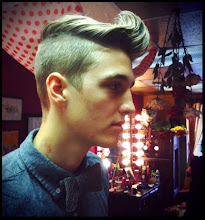Jean Giraud is a French comic artist better known by the pseudonym Moebius. His work is really beautiful, its a bit of Herge's clean-line and some of the poignant, obsessive modeling that surely served as inspiration for artists like Anders Nilsen. I would highly suggest Arzach, and The Incal, the latter being written by Alejandro Jodorowsky who incidentally, is also responsible for the 1973 film The Magic Mountain.
Saturday, January 28, 2012
Thom Browne: Fall 2012 Menswear
Thom Browne has put out a truly spectacular menswear line for 2012. As always there are utterly peculiar plays on proportion, which in this case were, in my eyes, extremely successful (especially the belly-cardigan which I expect I will be wearing in the near future). I don't have much more to say about it aside from declaring my undying love for Thom, and making sure everyone notices the merkins.
Tuesday, January 24, 2012
DJ Smhoak Mosheein
Recently while in New York I visited a number of my favorite DIY venues. At one, the Big Snow Buffalo Lounge I saw a truly excellent show. All the bands were excellent, but DJ Smhoak Mosheein, who played between sets, was simply too fabulous to not post.
P.S. The images below are from Showpaper, an excellent resource if you are looking for DIY events in New York.
Thursday, January 19, 2012
L'Inconnue de la Seine
L'Inconnue de la Seine (The Unidentified Women of the Seine) was an unknown drowning victims whose death mask was a common fixture in the homes of Parisian Bohemians during the early 20th century. In his 1910 novel Die Aufzeichnungen des Malte Laurids Brigge, Rainer Maria Rilke makes reference to the mask:
"Der Mouleur, an dem ich jeden Tag vorüberkomme, hat zwei Masken neben seiner Tür ausgehängt. Das Gesicht der jungen Ertränkten, das man in der Morgue abnahm, weil es schön war, weil es lächelte, weil es so täuschend lächelte, als es wüßte."
"The caster I visit every day has two masks hanging next to his door. The face of the young one who drowned, which someone copied in the morgue because it was beautiful, because it was still smiling, because its smile was so deceptive – as though it knew."
And one of my favorite authors, Maurice Blanchot, who owned one of the reproduction, described her as
"une adolescente aux yeux clos, mais vivante par un sourire si délié, si fortuné, [...] qu'on eût pu croire qu'elle s'était noyée dans un instant d'extrême bonheur"
"a young girl with closed eyes, enlivened by a smile so relaxed and at ease... that one could have believed that she drowned in an instant of extreme happiness"
Wednesday, January 18, 2012
Moomintroll
Moomintroll is a series of children's books written by Finnish Swede Tove Jansson. Not only are they some of the most elegant representations of the subtle melancholy of childhood, they also represent a distinctly Swedish aesthetic principle concerned with the elegance of the ephemeral, a concept also central to Japanese aesthetics and known as Wabi Sabi. These books may be partially responsible for my generally wistful temperament, however the very pervasive and beautiful sadness, the bittersweet concession to impermanence which has left me so ill adjusted, is what makes these books some of the greatest children's literature I have ever encountered.
Monday, January 16, 2012
Sunday, January 15, 2012
The Teenage Apocalypse Trilogy: Hysterical Realism at its Best
I recently watched Gregg Araki's 1997 film Nowhere and was shocked by the ease with which it fit into my much loved tradition of Barth's Research and Development and Wallace's Hysterical Realism. Perhaps it is something to do with my relative youth, but until recently I have been able to conceptualize the nineties within an ideological whole, this is to say the zeitgeist had not yet crystallized in my understanding. However, upon viewing Nowhere, I began to feel as if I could identify a common thread in the media of the era. This spirit of course runs from the late eighties into the early naughts, and yet an undeniable connection does seem to exist. Take for example Pee-Wee's Playhouse, David Burn's True Stories, and of course Wallace's Infinite Jest. In all Woods' identifying traits are present. Characters are underdeveloped, dialogue is wooden, affects are simultaneous melodramatic, mysterious, and flattened. Still, all this takes place against a background of extreme, fantastic, over stimulation. In Infinite Jest this background is an allegorical, future American Federation, dubbed, in a Pynchonian homage, O.N.A.N. The environments are complex, sensual, and theatrical, inhuman characters play out their deadened existences against a backdrop of impossible spaces, spaces more complex than the characters themselves. Clearly the characters exist within a world deadened by irony and cynicism, humanity has been robbed of its humanity, or rather our humanity has, in an osmotic fashion, drained from us into our surroundings, our media. As Wallace pointed out in his 1993 essay E Unibus Pluram: Television and U.S. Fiction, media has become so self aware it has made us into into passive, alienated consumers of the very forces that pacify and alienate us. Anyway, that's the diatribe, now watch the movie.
Anne Sofie Madsen
The Insanely talented and depressingly young designer Anne Madsen had her first runway show at Copenhagen fashion week in 2010. Aside from incredible apparel work she is also a gifted illustrator, and an excellent person to look at if you want to bemoan your own lack of accomplishments.
Subscribe to:
Posts (Atom)























































